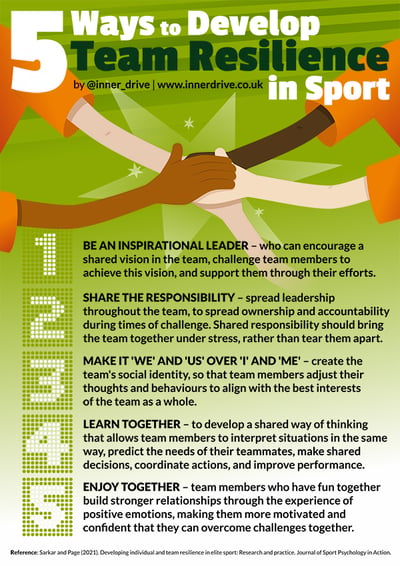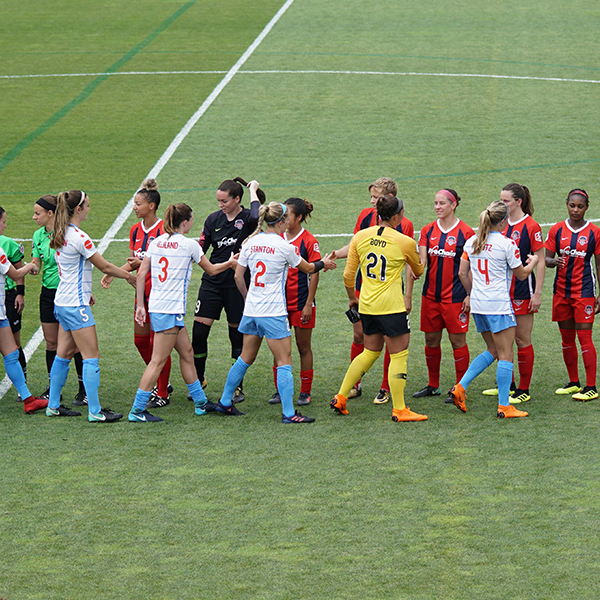You may have read our blog on developing individual resilience in elite sports. But for those who play in team sports, it’s important not only for each individual member of the team to be resilient, but also for the team as a whole to have resilience.
Developing team resilience is a very different task, because the team as a whole may face different challenges to those experienced individually. So, the team needs resources and skills to protect them from the negative effects of stressors they encounter together. Recent research has outlined some practical ways to develop team resilience in elite sports.
The research found that when teams adopted these practices, team members found the performance of the team to improve, as well as team members’ well-being. So, how do we develop team resilience in elite sport?
Have an Inspirational Leader
Firstly, a big factor in team resilience is having a strong leader. This person should be able to inspire their teammates, to motivate them, boost their morale, and improve their performance during challenging times. The researchers suggest three key leadership behaviours for developing team resilience:
- Vision - encourage the team to develop a positive vision for the future, and reinforce the belief that they can meet that vision.
- Challenge - maintain high expectations of the team, and set goals that will stretch the team to its full potential
- Support - encourage and motivate teammates, as well as showing respect for them and considering their personal feelings and needs.
Share the Responsibility
Although one key leader for the team is important, it’s also good practice to have several other leaders or groups of leaders throughout the team. As well as helping others in the team to develop leadership skills, this spreads responsibility through the team. This way, times of stress and challenge are likely to bring the team together, rather than tear them apart.
It’s important that each individual member knows their role within the team, that the group establishes norms of how to behave in the team, and that the team has regular discussions where honest feedback and sharing of ideas are encouraged. Having several leaders spread through the team, and following these kinds of practice, should mean the team as a whole is better connected. This means that when they face setbacks, they are all on the same page about what to do.
Make it ‘We’ and ‘Us’ over ‘I’ and ‘Me’
Team resilience can also be built through developing a strong team social identity. When team members have a collective identity, they become more emotionally attached to the group and will adjust their thoughts and behaviours to align with the group and its best interests as a whole. It helps them to put ‘we’ over ‘I’. The research suggests that several questions can help develop this team identity:
- Why is it important for the team to have an identity? Why do team members need to look out for and support each other?
- What are the team’s core values?
- What goals does the team strive to achieve, and what barriers might they face?
- What strategies can the team use to reach their shared goals?
- And how can the team track their progress towards these goals?
Learn Together
Another key way for teams to develop resilience is learning together. This means collectively gathering information and acting on new information after setbacks. Resilient teams know how their team works together best and can adapt their behaviour accordingly. Learning together allows the team to interpret situations similarly, anticipate and predict teammate needs, make shared decisions, and coordinate their actions towards shared goals, resulting in improved performance.
This in-sync behaviour prepares the team for routine and unexpected stressors, allowing them to adapt to and overcome these; they know what to do and what others in their team will do. This common knowledge also helps develop the team’s shared identity. In other words, teams who learn together, work together. This kind of collective learning can be encouraged through:
- Reviewing performances together;
- Training together, including working through simulated challenges and problems;
- Planning together, so that every member of the team understands a given task;
- Socialising together, allowing teammates to know and understand each other even better.
Enjoy together
Finally, teams who can have fun together and experience positive emotions as a group are more resilient. This allows them to be more enthusiastic, optimistic, satisfied and relaxed. This joint positivity brings team members closer together, helps to release any tensions, and makes the team more motivated and confident that they can deal with and overcome challenges together. Positive team emotions can be fuelled by:
- Encouraging the team to look after their well-being during challenging situations;
- Using humour in challenging situations;
- Having team socials;
- Developing pre-match routines;
- Encouraging team members to laugh about and celebrate recent times where they have overcome challenges together. This boosts the team’s confidence, helping them to bounce back after defeat.
Final thought
It is not always easy for teams to work well together. When a group of different people are put together, there can be clashes, differences of opinion, and tensions. This can make it hard for the team to work together to perform under pressure and overcome challenges. That’s why it’s so important for elite sport teams to be able to build and work on their resilience. We hope these tips provide some practical ways that they can do so.






